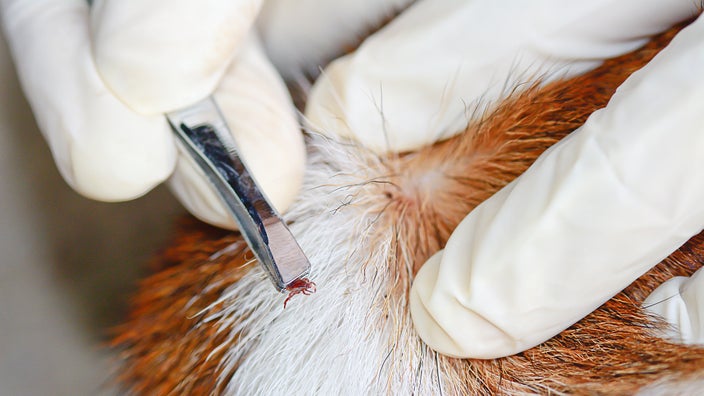To remove a tick from a dog, use fine-tipped tweezers to grasp the tick as close to the skin as possible and pull straight upward with steady pressure. Ticks can be a common nuisance for dogs, especially during warmer months when they spend more time outdoors.
These blood-sucking parasites can transmit diseases, so it’s important to promptly and properly remove them from your pet. We’ll discuss the steps to safely remove a tick from your dog, as well as preventive measures and potential health risks associated with ticks.
By following these guidelines, you can ensure your dog stays healthy and free from tick-borne illnesses.
Understanding Tick Removal From Dogs
It is important to safely remove ticks from dogs to prevent the transmission of diseases such as Lyme disease and Rocky Mountain spotted fever. Improper tick handling can lead to risks such as leaving mouthparts in the skin or causing an infection. To safely remove a tick, use fine-tipped tweezers to grasp the tick as close to the skin’s surface as possible. Pull upward with steady, even pressure, making sure not to twist or jerk the tick, to avoid leaving any parts behind. Clean the bite area and your hands with rubbing alcohol, an iodine scrub, or soap and water. Additionally, it’s vital to monitor the dog for any signs of illness or changes in behavior and consult a veterinarian if needed.
Identifying The Tick
Identifying the Tick: Recognizing the tick’s body and differentiating between tick species are crucial in locating the tick on your dog. Ticks vary in size, color, and shape according to species, life stage, and whether they have fed. Carefully examining your dog’s skin, especially in areas such as the ears, neck, and feet where ticks are likely to attach, is essential. Engaging in routine tick checks after outdoor activities can help in early detection. Consult a veterinarian for proper tick removal techniques to mitigate any potential health risks for your furry friend.
Pre-removal Preparations
When it comes to pre-removal preparations for removing a tick from your dog, it’s important to take the necessary steps to ensure a smooth and safe procedure. First and foremost, calming your dog for the procedure is crucial. This can be achieved by speaking to your dog in a soothing voice and gently stroking them to help them relax. Additionally, using protective gloves is essential to avoid direct contact with the tick and reduce the risk of disease transmission. Gather the necessary tools for removal, including fine-tipped tweezers or a tick removal tool. These tools will help ensure the tick is removed completely and safely, without leaving any body parts behind.
Fine-tipped Tweezers Method
Fine-Tipped Tweezers Method: Using fine-tipped tweezers, grasp the tick as close to the skin’s surface as possible. With steady, even pressure, pull the tick upward without twisting or jerking to avoid leaving mouthparts behind.
Step-by-step tweezers technique: Ensure a firm grip on the tick and steadily pull upward. Clean the bite area with alcohol and disinfect the tweezers. Finally, dispose of the tick by placing it in rubbing alcohol, flushing it down the toilet, or sealing it in a bag.
Tick Removal Hook Tool
When removing ticks from your dog, using a tick removal hook tool offers several advantages. Firstly, the hook tool helps to ensure the tick is safely and completely removed, reducing the risk of leaving any part of the tick’s body in the skin. Additionally, the hook minimizes the chance of squeezing the tick, which could lead to the transmission of infections. The removal process involves gently twisting the hook until the tick releases its grip, allowing for a smooth and efficient removal. Knowing when to use a tick hook is essential, and it’s particularly beneficial when dealing with tiny or embedded ticks where other methods may be less effective.
Specialized Tick Removal Lotions And Sprays
Specialized tick removal lotions and sprays can be effective in removing ticks from your dog. These chemical removal agents work by suffocating the tick and making it easier to extract. When applying topical treatments, ensure that you follow the instructions carefully and apply the product directly to the tick. After using chemical removal agents, it’s important to monitor your dog for any adverse reactions. Keep an eye out for redness, swelling, or irritation at the application site. If you notice any unusual symptoms, contact your veterinarian immediately. Remember that these products should be used with caution and always follow the recommended dosage to keep your pet safe and tick-free.
Inspect For Additional Ticks
When inspecting your dog for ticks, it’s important to thoroughly check their entire body, including hidden areas such as between toes, under armpits, and inside ears. Carefully run your hands over their fur, feeling for any small bumps. Using a fine-toothed comb can also help identify and remove ticks. Take note of any unusual behavior or symptoms, as this could indicate the presence of tick-borne diseases. Regular monitoring for changes in your dog’s health and well-being is crucial. If you notice any signs of illness, consult a veterinarian immediately to ensure proper care and treatment.
Post-removal Dog Care
After removing a tick from your dog, it’s important to clean the bite area with a gentle antiseptic and apply an antibacterial treatment. If the bite is deep or shows signs of infection, bandaging may be necessary. Keep a close eye on your dog for the next few weeks and monitor the bite area for any swelling, redness, or irritation. Seek veterinary care if you notice any concerning symptoms or if your dog starts to show signs of illness.
To prevent future tick bites, consider using preventative measures such as tick prevention medications, regularly checking your dog for ticks after outdoor activities, and avoiding tick-infested areas whenever possible.
Monitoring The Removal Site
When removing a tick from your dog, monitor the removal site for any signs of infection, such as redness, swelling, or discharge. It’s important to keep a close eye on the area to ensure proper healing. Typically, the wound should start to heal within a few days, and you should notice typical healing signs, such as scab formation and reduced irritation. However, if you observe any abnormal symptoms, consult your veterinarian immediately. Managing your dog’s comfort levels during this period is crucial. Keep your dog from excessively licking or scratching the site, and follow any post-removal care instructions provided by your vet.

Credit: yourpetandyou.elanco.com
Frequently Asked Questions For How Do You Get A Tick Off A Dog
What Is The Safest Way To Remove A Tick From A Dog?
To safely remove a tick from your dog, use fine-tipped tweezers to grasp the tick as close to the skin as possible. Pull upward with steady, even pressure. After you remove the tick, clean the bite area and your hands with rubbing alcohol, an iodine scrub, or soap and water.
Can I Use Household Items To Remove A Tick From My Dog?
Avoid using home remedies like matches, petroleum jelly, or nail polish to remove ticks. These methods can actually increase the risk of infection or distress for your dog. Stick to using fine-tipped tweezers and follow proper tick removal techniques for the safest and most effective results.
How Can I Prevent Ticks From Latching Onto My Dog?
To prevent ticks from latching onto your dog, use a tick repellent recommended by your veterinarian. Check your dog for ticks after walks or time spent outdoors, especially in wooded or grassy areas. Keep your yard tidy by mowing the lawn, removing leaf litter, and creating a barrier between your yard and wooded areas.
Should I Be Concerned If I Find A Tick On My Dog?
If you find a tick on your dog, it’s important to remove it promptly and monitor for any signs of illness or changes in behavior. Keep an eye out for symptoms such as fever, loss of appetite, and lethargy. Inform your veterinarian if you notice any concerning changes in your dog’s health after tick removal.
Conclusion
It’s essential to carefully and promptly remove ticks from your dog to prevent potential health risks. By using safe and effective methods, such as tick removal tools or seeking veterinary assistance when necessary, you can help keep your canine companion healthy and happy.
Stay informed and proactive in safeguarding your pet from tick-borne diseases.



